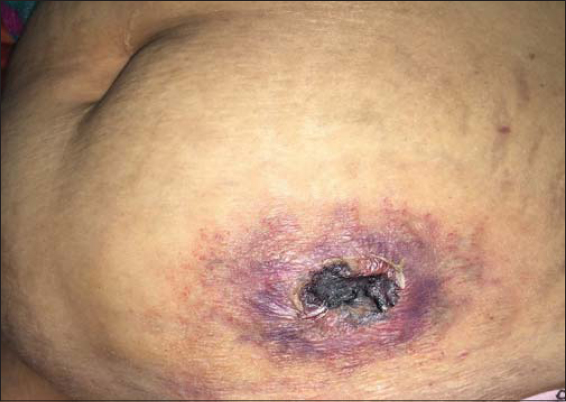Ecthyma gangrenosum in a patient with febrile pancytopenia
Samia Mrabat , Hanane Baybay, Ryme Dassouly, Zakia Douhi, Sara Elloudi, Fatima Zahra Mernissi
, Hanane Baybay, Ryme Dassouly, Zakia Douhi, Sara Elloudi, Fatima Zahra Mernissi
Department of Dermatology, University Hospital Hassan II, Fes, Morocco
Corresponding author: Samia Mrabat, MD
How to cite this article: Mrabat S, Baybay H, Dassouly R, Douhi Z, Elloudi S, Mernissi FZ. Ecthyma gangrenosum in a patient with febrile pancytopenia. Our Dermatol Online. 2022;13(1):98.
Submission: 10.12.2020; Acceptance: 06.03.2021
DOI: 10.7241/ourd.20221.24
Citation tools:
Copyright information
© Our Dermatology Online 2022. No commercial re-use. See rights and permissions. Published by Our Dermatology Online.
Ecthyma gangrenosum (EG) is a cutaneous infection most commonly associated with Pseudomonas bacteremia and usually occurring in immunocompromised patients [1]. The infection progresses sequentially from a maculopapular rash to hemorrhagic bullae, then to necrotic ulcerations with surrounding erythema [2]. Herein, we report a case of ecthyma gangrenosum in an immunologically compromised patient.
A 65-year-old female was admitted to the oncohematology department for febrile pancytopenia. Blood work revealed severe thrombocytopenia at 15,000/mm³), an absolute neutrophil count of 180 cells/mm³, and anemia. A sternal bone marrow puncture found 15% of plasma cells. Four days after the admission, the patient had a painful, quickly extending lesion on the abdomen. She described erythema that progressed to pustules, then ulcerations. On general clinical evaluation, the patient was feverish at 40°C. A dermatological examination revealed the presence of a 6 cm purpuric patch on the left flank with a central necrotic eschar (Fig. 1). The diagnosis of ecthyma gangrenosum was reached and the patient was treated with ceftazidime and vancomycin. Unfortunately, having gone into septic shock, the patient died one week later.
 |
Figure 1: Purpuric patch with irregular borders and a central necrotic eschar. |
Consent
The examination of the patient was conducted according to the principles of the Declaration of Helsinki.
The authors certify that they have obtained all appropriate patient consent forms, in which the patients gave their consent for images and other clinical information to be included in the journal. The patients understand that their names and initials will not be published and due effort will be made to conceal their identity, but that anonymity cannot be guaranteed.
REFERENCES
1. Khoo T, Ford F, Lobo Z, Psevdos G. One thing after another:Ecthyma gangrenosum. Am J Med. 2018;131:510-1.
2. Abdou A, Hassam B. [Ecthyma gangrenosum]. Pan Afr Med J. 2018;30:95.
Notes
Source of Support: Nil,
Conflict of Interest: None declared.
Request permissions
If you wish to reuse any or all of this article please use the e-mail (brzezoo77@yahoo.com) to contact with publisher.
| Related Articles | Search Authors in |
|
 http://orcid.org/0000-0003-3455-3810 http://orcid.org/0000-0003-3455-3810 http://orcid.org/0000-0002-5942-441X http://orcid.org/0000-0002-5942-441X |



Comments are closed.